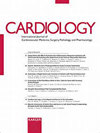投稿信息
投稿信息
审稿周期
投稿命中率
审稿费用
暂无数据
版面费用
暂无数据
中国人发表比例
2023年中国人文章占该期刊总数量暂无数据 (2022年为100.00%)
自引率
3.2 %
年文章数
1418
作者需知
暂无数据
NCBI查询
期刊简介
稿件收录要求
稿件收录要求
Cardiologyí features high-quality papers from all over the world to keep its readers regularly informed of current strategies in the prevention, diagnosis and treatment of heart disease. These papers not only describe but offer critical appraisals of new developments in non-invasive, invasive, diagnostic and therapeutic methods. The importance of experimental work is also acknowledged through reports covering the function and metabolism of the heart and the morphology and physiology of cardiovascular disease. Special sections in a variety of subspecialty areas reinforce the journalís value as a complete record of recent progress for all cardiologists, internists, cardiac surgeons and clinical physiologists.
''Cardiology'' publishes original reports in research and observations pertaining to cardiovascular physiology, epidemiology, pharmacology, disease and therapy.
Only original papers written in English are considered. The articles should be readily comprehensible to a reader who is fluent in English. Therefore, all manuscripts originating from non-English-speaking authors must be edited prior to submission to assure that standard English grammar and usage are observed. This may require help from a colleague or other editorial assistant. It must be evident from the covering letter that this has been done. Submissions that are not edited in this way will not be considered for publication until such editing has been achieved.
Manuscripts should be submitted online
Only original papers written in English are considered. The articles should be readily comprehensible to a reader who is fluent in English. Therefore, all manuscripts originating from non-English-speaking authors must be edited prior to submission to assure that standard English grammar and usage are observed. This may require help from a colleague or other editorial assistant. It must be evident from the covering letter that this has been done. Submissions that are not edited in this way will not be considered for publication until such editing has been achieved.
Manuscripts should be submitted online
Main Sections
- Original Research
- Original Research – Clinical Trial Design
Submissions will be accepted reporting the study design protocols of planned clinical trials that have been appropriately registered with regulatory authorities. These submissions will be limited to 4500 words and 35 references. - Review
- Turning Basic Research into Clinical Success
One or two focused review articles are published in each issue, and should offer an overview of existing concepts and literature in a format assimilable to the largely clinical cardiologist readership, i.e. a readership base with limited sophistication as to methods and terminology associated with cell and molecular biology. Most manuscripts are submitted upon invitation. Authors planning to submit an unsolicited paper are requested to contact the Editorial Office with an outline of the intended contribution. All submissions are subject to peer review. These articles are available also to nonsubscribers in free access on the journal''s website. Submissions should comprise no more than 4,500 words and 50 references. They should have an abstract of approximately 200 words and about 5 key words should be provided. - Letter to the Editor
Letters to the Editor (max. 1,500 words, including references) are encouraged if they directly concern articles previously published in this journal and issues raised by those articles. The Editor reserves the right to submit copies of such letters to the authors of the articles concerned prior to publication in order to permit them to respond in the same issue of the journal. - Novel Insights from Clinical Experience (formerly Case Reports)
Contributions to this section are expected to provide novel insight into a clinical problem. Submissions can be based on a single case or a number of similar cases. While a case report can describe an entirely novel clinical condition, we recognise that it is unlikely that most case reports will provide such information. In the more common setting of a description of a well-recognized condition, the most important aspect of the presentation, on which editorial judgments will be based, is the description of the new perspective(s) on the phenotype, pathophysiology, clinical presentation, evaluation strategy and/or management that can be drawn from the case findings.
Highlighted boxes containing one or two bullet points on ''Established facts''and ''Novel insights'' are required and should be placed on the first page of the report. These should be selected so as to reinforce the novelty of the clinical observation.
ExampleEstablished Facts
· Already known fact 1 ...
· Already known fact 2 ...
· ...Novel Insights
· New information 1 ...
· New information 2 ...
· ...
The manuscript should be presented with an abstract (up to 200 words), brief introduction, case or case series description and results, followed by a discussion. "Novel Insights from Clinical Experience" should be no more than 2,500 words (including statements in the highlighted box) and should contain no more than 20 references. Please note that case reports that are not submitted in this format will not be considered, and that such reports cannot be submitted as Letters to the Editor. - Short Communications
These manuscripts should not contain more than 2,000 words, including key words, essential references (not more than 15) and not more than 3 tables or figures. Such communications should represent complete, original studies and should be arranged in the same way as full length manuscripts. - Commentary
Authors who wish to contribute a manuscript to this category should contact the Editor. Commentaries should offer a more personalized perspective on a topic that will be of interest to the general readership, paralleling Editorials (defined as commentaries invited by the Editors or opinion pieces produced by members of our editorial board). All contributions to this category will be subject to editorial review for relevance for the readership, perception of topicality and general importance/interest, and quality of the submitted work. To submit a "Letter to the Editor", see point 5. above.




